Introduction: Your Computer is a Team
Welcome! If you’ve ever wondered what’s actually inside the boxy case of a computer, you’ve come to the right place. Thinking about a computer can be intimidating. It seems like a magical box that just “works.” But the truth is, it’s not magic at all. It’s a collection of specialized parts, each with a very specific job. The best way to understand it is to think of a computer not as one single thing, but as a highly-skilled team.
Imagine you’re running a company. You need a brilliant CEO to make all the big decisions. You need a fast and organized assistant who can hold onto the information the CEO needs right now. You need a massive library to store every file and piece of information the company has ever created. You need a communication system so everyone can talk to each other. You need a talented artist to create all the visuals. And you need a power plant to keep the lights on for everyone.
Every single part of a computer has a role just like this. When they all work together well, your company (your computer) runs smoothly and efficiently. If one member of the team is slow or not very good at their job, it can slow everyone else down. Throughout this course, we will meet each member of this “hardware team.” We’ll learn their names, what their specific job is, how to tell if they are good at their job, and how they work with the rest of the team. By the end, you’ll be able to look at a computer’s parts list and understand exactly what you’re looking at, just like reading the roster of a championship sports team.

Chapter 1: The Brain – The Central Processing Unit (CPU)
The Analogy: The CEO or The Brain
The CPU is the most important part of the computer’s “team.” It’s the boss, the brain, the CEO. Its job is to receive instructions from you and the software you’re using, and then tell all the other parts of the computer what to do. Every time you click your mouse, type on your keyboard, or open a program, the CPU is what figures out what needs to happen next. A faster, more powerful CPU is like a smarter, quicker-thinking brain. It can handle more tasks at once and finish them faster.
The Central Processing Unit, or CPU, is a small square chip that sits in a special socket on the main circuit board of your computer (we’ll meet that part later, it’s called the motherboard). Despite its small size, it’s arguably the most critical component for your computer’s overall speed and responsiveness for everyday tasks. When people talk about a computer being “fast” or “slow,” they are often, directly or indirectly, talking about the performance of the CPU.
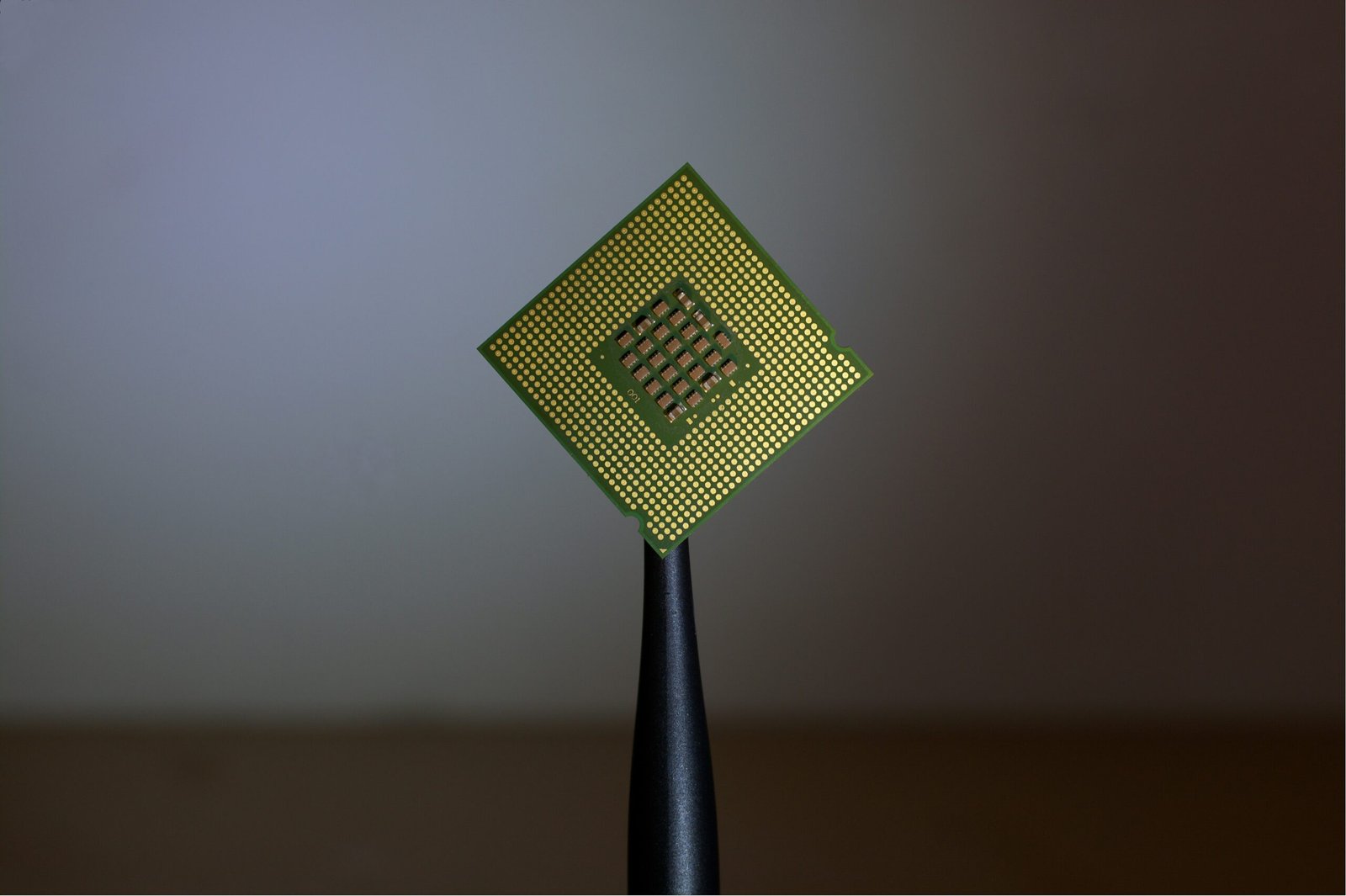
How Do We Measure a CPU’s Power?
It’s not just one thing that makes a CPU “good.” It’s a combination of a few key factors. Let’s break them down in simple terms.
Cores and Threads: How Many Workers It Has
Imagine the CPU is a chef in a kitchen. In the old days, a CPU was like one chef trying to do everything—chop vegetables, cook the steak, and wash the dishes. This is a “single-core” processor.
Modern CPUs are like having multiple chefs in the kitchen at the same time. Each “chef” is called a core. A dual-core CPU has two chefs. A quad-core has four. An octa-core has eight. The more cores a CPU has, the more tasks it can genuinely work on at the exact same time. This is called multitasking.
Then there’s something called threads. You can think of a thread as a chef’s pair of hands. Some advanced CPUs have a technology (often called “Hyper-Threading” by Intel or “SMT” by AMD) that lets one chef (one core) work on two separate tasks at once, like having an extra set of virtual hands. So, a CPU with 8 cores and 16 threads is like having 8 chefs, each of whom can juggle two recipes simultaneously. This makes the computer feel incredibly responsive, especially when you have many programs open at once, like a web browser, music, and a game.
Clock Speed: How Fast Each Worker Works
Clock speed is measured in gigahertz (GHz). It tells you how many calculations a single core can perform every second. A 3.5 GHz CPU, for example, can perform 3.5 billion cycles per second. It’s a measure of raw speed.
Think of our chefs again. Clock speed is how fast each chef can chop vegetables. Having more chefs (cores) is great for making many different dishes at once. But if you’re only making one simple dish (running one simple program), the speed of the single chef working on it (clock speed) becomes very important. For some tasks, like many video games, having a very high clock speed can be more important than having a huge number of cores.
Cache: The CPU’s Personal Pantry
The CPU needs data to work on. It gets this data from another part called RAM (which we’ll cover in the next chapter). But going to the RAM to get data is like a chef having to walk to a big storage room down the hall every time they need an ingredient. It’s slow.
To fix this, the CPU has its own tiny, super-fast storage right on the chip itself. This is called cache. It’s like the chef’s personal little pantry right at their cooking station, holding the most frequently used ingredients. The bigger and faster the cache, the less time the CPU wastes waiting for data, and the faster it can get its job done.
The Big Two: Intel vs. AMD
For decades, the computer world has been dominated by two main CPU manufacturers: Intel and AMD. For a long time, Intel was seen as the undisputed king. Today, the competition is incredibly fierce, which is great for us as consumers! Both companies make fantastic CPUs at every price point.
- Intel: Known for their “Core” series of processors (Core i3, Core i5, Core i7, and Core i9). The higher the number, the more powerful the CPU generally is. Core i3 is for basic budget computers, i5 is the sweet spot for most people and gamers, i7 is for high-end gaming and creative work, and i9 is for professionals who need the absolute best performance.
- AMD: Known for their “Ryzen” series (Ryzen 3, Ryzen 5, Ryzen 7, and Ryzen 9). They follow a similar naming system. Ryzen CPUs have become famous for offering a large number of cores and threads for the price, making them excellent for tasks that can use all those “chefs,” like video editing or running many programs at once.
Which one is better? It honestly changes every year! The best approach is to look at reviews for the specific task you want to do (like gaming or video editing) for CPUs in your budget at the time you’re buying.
Chapter 1 Key Takeaways
- The CPU is the brain of the computer; it processes all instructions.
- Cores are like individual workers. More cores = better multitasking.
- Clock Speed (GHz) is how fast each worker is. Higher is better for single-program speed.
- Cache is the CPU’s super-fast memory, which helps it work more efficiently.
- Intel (Core i3/i5/i7/i9) and AMD (Ryzen 3/5/7/9) are the two main brands, and both are excellent choices.
Chapter 2: The Workbench – Random Access Memory (RAM)
The Analogy: A Workbench or a Desk
If the CPU is the brain doing the thinking, RAM is its personal workbench. When you decide to work on a project (open a program), you take the tools and materials for that project out of storage and put them on your workbench. The bigger your workbench, the more projects and tools you can have out at the same time without everything becoming cluttered and slow. If your workbench is too small, you have to constantly put things away to make room for new things, which takes a lot of time.
Random Access Memory, or RAM, is your computer’s short-term memory. It’s where your computer holds all the data for the programs and files that you are actively using. When you double-click on an application like Google Chrome, the computer loads the application from your long-term storage (which we’ll discuss in the next chapter) into the RAM. The CPU can then access the data from RAM incredibly quickly, which is what makes your computer feel fast and responsive.
The key thing to remember about RAM is that it’s volatile. This means that when you turn off your computer, everything on the workbench (in the RAM) is cleared away. It’s temporary. This is why you need to save your work to a file, which puts it into long-term storage.
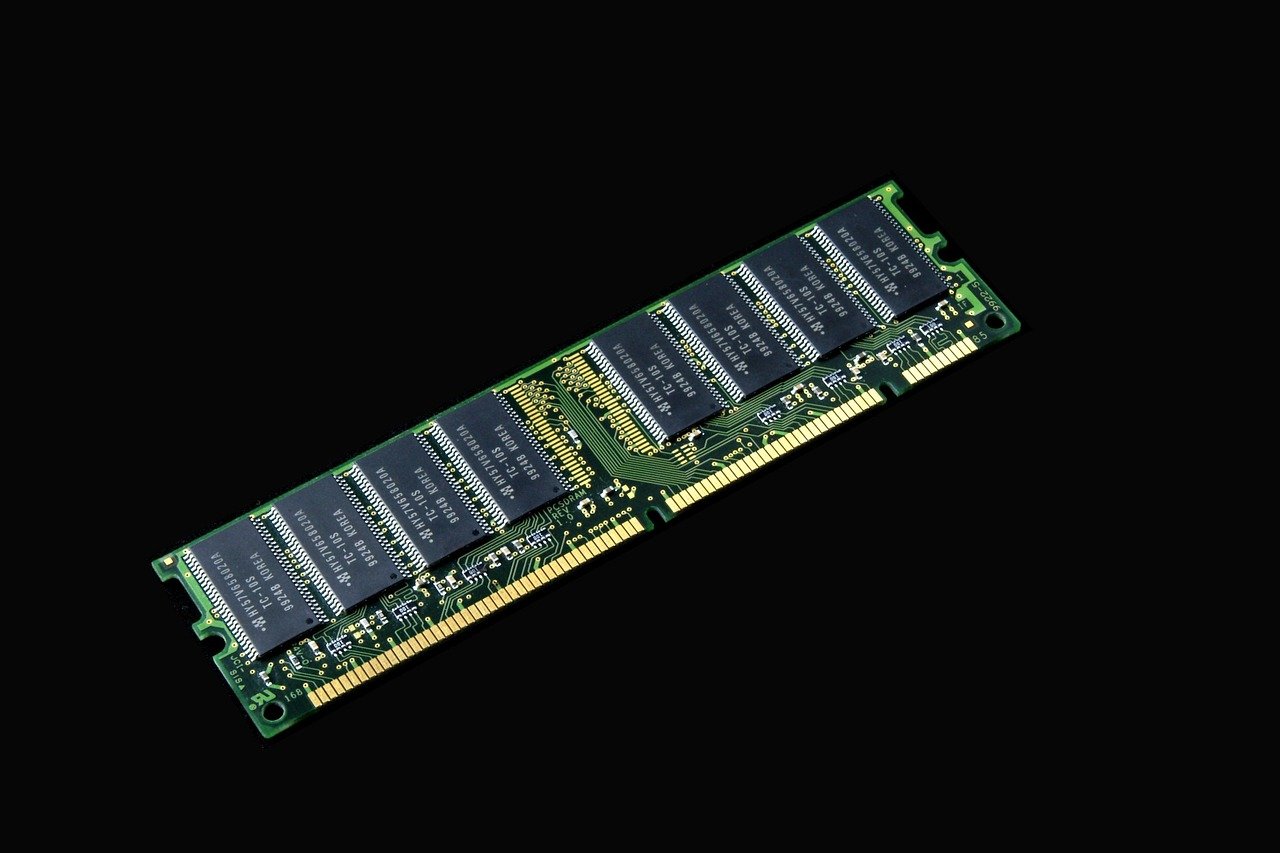
How Much RAM Do I Need?
RAM is measured in gigabytes (GB). The amount of RAM you need is like asking how big of a workbench you need. It completely depends on the work you do.
- 8 GB: This is the bare minimum for a modern computer. It’s enough for light use, like browsing the web (with a few tabs open), sending emails, and writing documents. You might find it feels slow if you try to do too much at once.
- 16 GB: This is the sweet spot for most people, including most gamers. It gives you plenty of “workbench space” to run a game, have a web browser with many tabs open, and maybe a music app all at the same time without the system slowing down.
- 32 GB: This is for serious enthusiasts, professionals, and heavy multitaskers. If you do a lot of video editing (especially with 4K video), 3D modeling, or you run complex scientific programs, 32 GB will ensure you never run out of space.
- 64 GB or more: This is overkill for almost everyone. This amount is for professional workstations dealing with extremely large files, like Hollywood-level video effects or massive architectural models.
It’s Not Just About Size: RAM Speed and Type
Just like with a CPU, it’s not only about the size or amount. The speed of your RAM also matters. Think of it as how quickly you can grab a tool from your workbench. A faster workbench means the CPU wastes less time waiting.
DDR4 vs. DDR5
You will see RAM labeled as either DDR4 or DDR5. This just refers to the generation of the technology. DDR stands for “Double Data Rate.”
- DDR4: This has been the standard for many years. It’s reliable, affordable, and still plenty fast for most applications.
- DDR5: This is the newest and fastest generation. It offers significantly higher speeds and more bandwidth (more data can be moved at once). While it’s more expensive, it’s becoming the new standard for high-end computers, especially those with the latest CPUs from Intel and AMD that can take advantage of the extra speed.
You can’t mix and match! Your motherboard (Chapter 4) will be designed for either DDR4 or DDR5, and you must buy the correct type of RAM to fit it.
Dual-Channel Mode: Two Hands are Better Than One
Your motherboard has several slots for RAM sticks. Most motherboards support something called “dual-channel mode.” This is a fancy way of saying the CPU can talk to two RAM sticks at the same time, doubling the speed at which it can get data.
To make this work, you should always buy RAM in a kit of two (or four) sticks instead of one single stick. For example, to get 16 GB of RAM, it is much, much better to buy a kit of two 8 GB sticks (2 x 8GB) than to buy one single 16 GB stick. By installing the two sticks in the correct slots on the motherboard (your motherboard manual will show you which ones), you enable dual-channel mode and get a significant, free performance boost!
Chapter 2 Key Takeaways
- RAM is the computer’s fast, short-term memory or “workbench.”
- It’s volatile, meaning it’s cleared when the power is turned off.
- 16 GB is the recommended amount for most users today.
- DDR5 is the newer, faster generation, while DDR4 is the more common, affordable standard. Your motherboard determines which type you can use.
- Always try to use two RAM sticks (e.g., two 8GB sticks for 16GB total) to take advantage of dual-channel mode for a free speed boost.
Chapter 3: The Library – Storage (HDD & SSD)
The Analogy: A Filing Cabinet or a Library
If RAM is the temporary workbench, then your storage drive is the permanent library or filing cabinet. This is where all your computer’s information is kept safely, even when the power is off. Your operating system (like Windows or macOS), all your programs, your documents, photos, games, and movies—everything lives here. When you want to work on something, the CPU sends a request to get the file from the library (storage) and put it on the workbench (RAM).
Storage is your computer’s long-term memory. Unlike RAM, it’s non-volatile, meaning it remembers everything even after you shut down the computer. The speed of your storage drive has a massive impact on how your computer *feels*. It determines how fast your computer turns on, how quickly your programs open, and how long it takes to load new levels in a game. Today, there are two main types of storage drives.
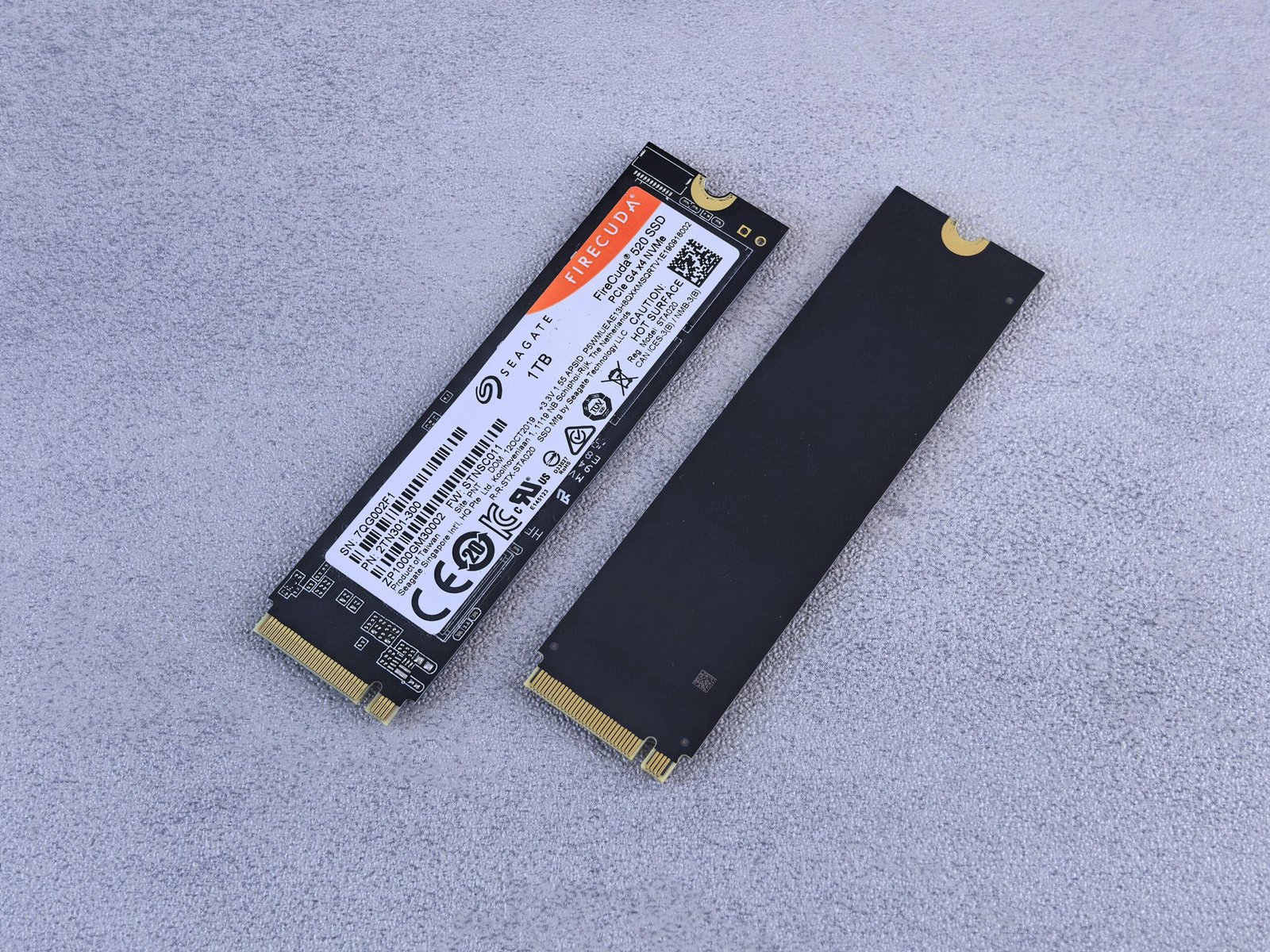
The Old Guard: Hard Disk Drives (HDD)
Hard Disk Drives, or HDDs, are the traditional form of computer storage. They have been around for decades. An HDD works like a tiny record player. Inside the metal case, there are spinning platters (the “records”) coated in a magnetic material. A read/write “arm” moves back and forth over these spinning platters to find and record data.
- Advantage: The biggest advantage of an HDD is cost. They are very cheap for the amount of storage you get. You can buy a massive 4 terabyte (TB) HDD for a relatively low price, making them great for storing huge files like movies or a large photo library that you don’t need to access instantly.
- Disadvantage: They are slow. Because they have physical, moving parts—the spinning platters and the moving arm—it takes time to find the data you’ve requested. This is why computers with only an HDD feel sluggish. They take a long time to boot up, and programs can take many seconds to open. They are also more fragile; dropping one can damage the moving parts inside.
The New Standard: Solid-State Drives (SSD)
Solid-State Drives, or SSDs, are the modern replacement for HDDs. The name “solid-state” means they have no moving parts. Instead, they store data on interconnected flash-memory chips, similar to a USB flash drive or the memory in your smartphone, but much faster and more reliable.
- Advantage: Speed! An SSD is dramatically faster than an HDD. A computer with an SSD boots up in seconds, programs open almost instantly, and the whole system feels incredibly snappy and responsive. Because they have no moving parts, they are also more durable and use less power.
- Disadvantage: Cost. While prices have come down a lot, SSDs are still more expensive per gigabyte than HDDs. A 1 TB SSD might cost the same as a 4 TB HDD.
NVMe vs. SATA SSDs: Good vs. Great
Even within the world of SSDs, there are different types. You’ll most commonly see “SATA” and “NVMe.”
- SATA SSDs: These are the more common, slightly older type. They often look like a 2.5-inch rectangle and connect to the computer with a cable. They are still fantastically fast—about 5-10 times faster than a regular HDD.
- NVMe SSDs: This is the latest and greatest. They look like a small stick of RAM and plug directly into a special M.2 slot on the motherboard, eliminating the need for cables. They are breathtakingly fast, often 5 to 10 times faster than a SATA SSD, or up to 50 times faster than an HDD! For tasks like transferring huge files or loading massive games, the difference is noticeable.
The Best of Both Worlds: A Common Strategy
Because of the cost difference, many people use a combination of both types of drives to get the best of both worlds:
- A smaller, fast SSD (like a 500 GB or 1 TB NVMe SSD) to act as the “boot drive.” You install your operating system (Windows) and your most-used programs and games on this drive. This makes your whole computer feel fast and responsive.
- A larger, cheaper HDD (like a 2 TB or 4 TB HDD) to act as a “data drive.” You use this drive to store your large media files—your movie collection, photos, music, and documents that you don’t need to access at lightning speed.
This hybrid approach gives you the instant responsiveness of an SSD for your system and the cheap, bulk storage of an HDD for your files.
| Feature | Hard Disk Drive (HDD) | Solid-State Drive (SSD) |
|---|---|---|
| Technology | Mechanical, with spinning platters | Electronic, with flash memory chips |
| Speed | Slow | Very Fast to Extremely Fast |
| Cost | Very cheap per gigabyte | More expensive per gigabyte |
| Best Use | Bulk storage for large files (movies, archives) | Operating system, programs, and games |
Chapter 3 Key Takeaways
- Storage is the computer’s permanent, long-term memory.
- HDDs are cheap and offer huge capacity, but are slow due to moving parts.
- SSDs are incredibly fast, making your whole computer feel responsive. They have no moving parts.
- For a modern computer, you should always have an SSD for your operating system.
- A common setup is a smaller SSD for programs and a larger HDD for files.
Chapter 4: The Nervous System – The Motherboard
The Analogy: The City’s Infrastructure or The Nervous System
If all the computer parts are members of a team, the motherboard is the office building and the communication network they all use. It’s the central hub that everything else plugs into. It’s the city’s road system that lets the power plant send electricity to the library, and the CEO send instructions to the artist. It doesn’t do the “work” itself, but without it, none of the other parts could talk to each other. A good motherboard ensures that information can flow quickly and reliably between all the other components.
The motherboard is the large main circuit board in your computer. It’s a complex web of circuits, slots, and ports that connects all the individual components. The CPU, RAM, storage drives, and graphics card all plug directly into the motherboard. It’s the foundation upon which the entire computer is built. While it doesn’t directly impact performance in the same way a CPU or SSD does, choosing the right motherboard is crucial because it determines what other parts you can use.
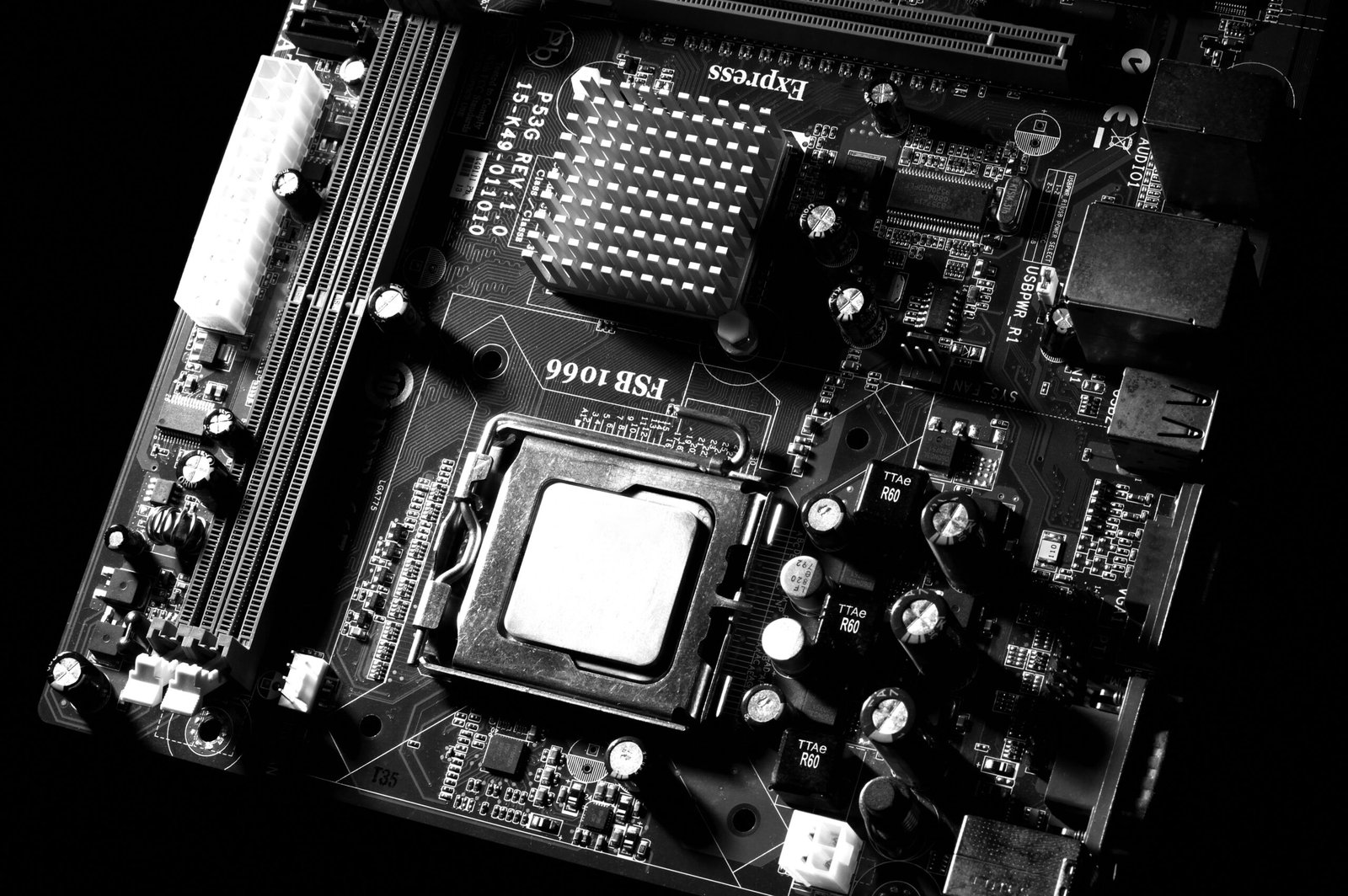
Key Parts of a Motherboard
When you look at a motherboard, it can seem like a confusing city map. But let’s focus on the main “landmarks” you need to know.
- CPU Socket: This is the square holder where the CPU is installed. The type of socket is very important! A motherboard designed for an Intel CPU will have a different socket than one for an AMD CPU. You cannot put an AMD CPU in an Intel motherboard, or vice-versa. Even within the same brand, different generations of CPUs might use different sockets. This is the first and most important compatibility check you must make.
- RAM Slots: These are the long, thin slots where you plug in your RAM sticks. As we learned, most motherboards have four slots to allow for dual-channel memory.
- PCIe Slots: The Peripheral Component Interconnect Express (PCIe) slot is a long slot used for expansion cards. The most important one is the top, reinforced slot, which is where your powerful graphics card (Chapter 5) will go. Other, smaller slots can be used for things like Wi-Fi cards or extra sound cards.
- Storage Connectors: This is where you plug in your storage drives. You’ll find small ports for SATA drives (HDDs and SATA SSDs) and, on modern boards, you’ll find the tiny M.2 slots for the super-fast NVMe SSDs.
- Rear I/O (Input/Output) Panel: This is the collection of ports you see on the back of your computer. It’s where you plug in your mouse, keyboard, monitor, speakers, and internet cable. This includes USB ports (in various speeds and types like USB-A and USB-C), an Ethernet port for wired internet, and audio jacks.
Size Matters: Form Factors
Motherboards come in a few standard sizes, called form factors. The size you choose will determine the size of the computer case you can use and how many features it can have.
- ATX: This is the standard, full-size motherboard. It offers the most slots and features, including multiple PCIe slots for expansion cards and plenty of room to work. This is the most common choice for gamers and builders who want maximum flexibility.
- Micro-ATX (mATX): This is a shorter, more compact version of ATX. It has fewer PCIe slots but is still very capable. It’s a great choice for building a slightly smaller, more budget-friendly computer that still has good performance.
- Mini-ITX: This is the smallest of the common form factors. It’s a tiny, square board with only one PCIe slot (for the graphics card) and usually only two RAM slots. These are used for building very small, compact computers that can fit on a desk or in an entertainment center.
The Chipset: The Traffic Controller
Every motherboard has a “chipset.” The chipset is a collection of chips that acts as the traffic controller for the entire board, managing the flow of data between the CPU, RAM, storage, and all the other ports. You don’t need to be an expert on chipsets, but you should know that they come in different tiers:
- Entry-Level Chipsets (e.g., Intel’s H-series, AMD’s A-series): These are the most basic and affordable. They provide all the essential features but might lack some of the high-speed ports or the ability to “overclock” (push the CPU faster than its factory settings).
- Mid-Range Chipsets (e.g., Intel’s B-series, AMD’s B-series): This is the sweet spot for most people. They offer a great balance of features, performance, and price. They usually have faster USB ports, more M.2 slots, and sometimes even overclocking support.
- High-End Chipsets (e.g., Intel’s Z-series, AMD’s X-series): These are the most expensive and feature-packed motherboards. They are designed for enthusiasts who want the absolute best performance, the most connectivity options, and robust overclocking capabilities to squeeze every last drop of speed out of their CPU and RAM.
Chapter 4 Key Takeaways
- The motherboard connects every component in the computer.
- It determines compatibility: You must match the motherboard’s CPU socket to the CPU (e.g., Intel with Intel).
- Common sizes are ATX (large), Micro-ATX (medium), and Mini-ITX (small).
- The chipset determines the features and quality of the motherboard. Mid-range “B-series” boards are great for most builds.
- The motherboard provides all the ports on the back of your PC.
Chapter 5: The Artist – The Graphics Processing Unit (GPU)
The Analogy: The Specialist Artist
While the CPU is a brilliant general-purpose brain, it’s not very good at one specific, very difficult task: drawing. Imagine asking a brilliant scientist to paint a masterpiece. They could probably figure it out, but it would be slow and not very pretty. The GPU, or graphics card, is a specialist. It’s a second, highly-focused brain that is designed to do one thing incredibly well: process visual information and draw the millions of pixels that make up the image on your screen. It’s the master artist on your computer’s team.
The Graphics Processing Unit, also known as a graphics card or video card, is responsible for creating everything you see on your monitor. From your desktop and web browser to complex 3D video games and high-resolution videos, the GPU’s job is to render these images quickly and smoothly. For many people, this is the single most expensive and powerful component in their entire computer, especially if they are a gamer or a creative professional.
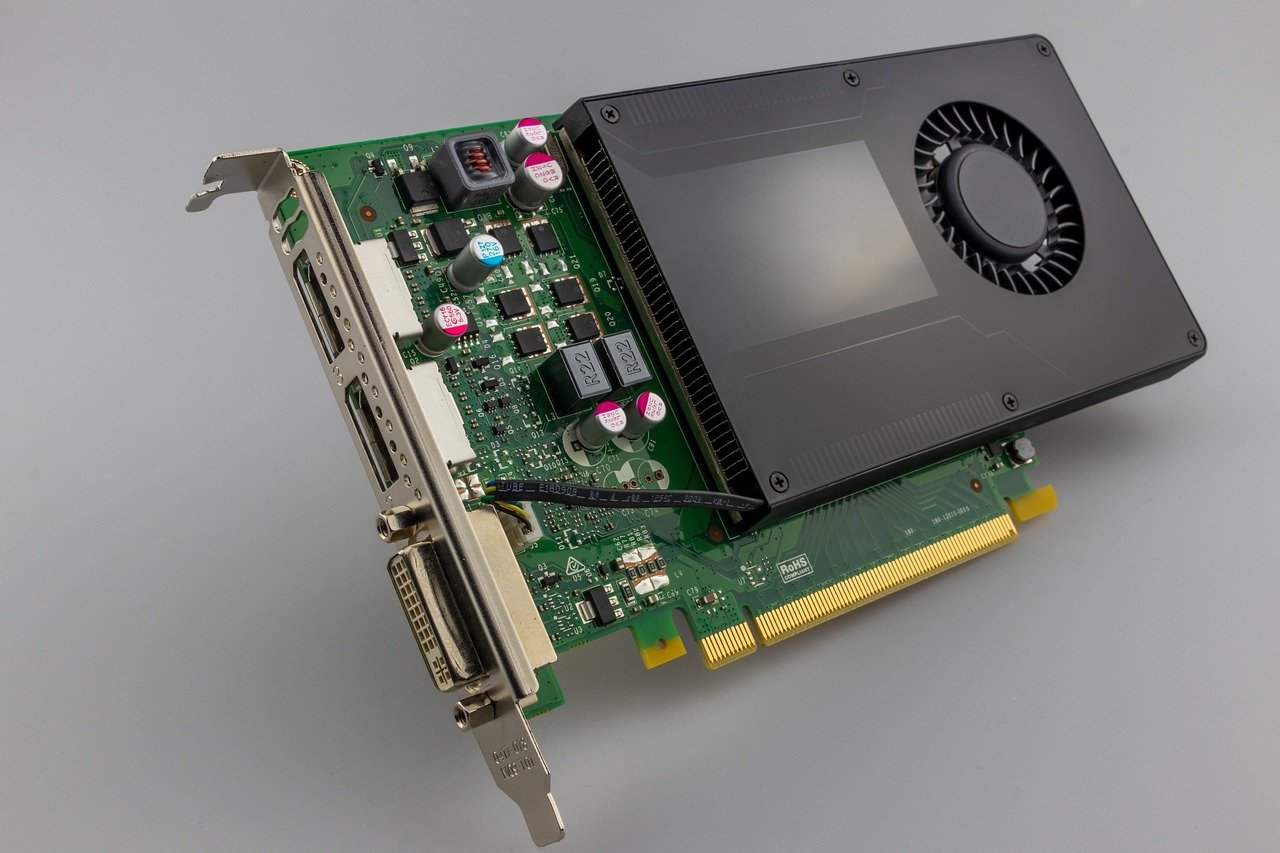
Integrated vs. Dedicated Graphics
Not all computers have a big, fancy graphics card. There are two main types of graphics processing.
- Integrated Graphics: This is when the graphics-processing capabilities are built directly into the CPU itself. It’s like our scientist brain having a little bit of drawing ability. Integrated graphics are very power-efficient and are perfectly fine for everyday tasks like watching videos, browsing the web, and doing office work. They are common in thin-and-light laptops and budget desktop computers. However, they are not powerful enough for demanding 3D games or serious video editing.
- Dedicated Graphics Card: This is a separate, powerful component that you plug into a PCIe slot on your motherboard. It has its own specialized processors and its own super-fast memory (called VRAM). This is the “master artist” we’ve been talking about. If you want to play modern video games at high settings, do 3D animation, or edit 4K video, you absolutely need a dedicated graphics card.
Key Specs of a GPU
When you look at different graphics cards, you’ll see a lot of confusing numbers. Let’s simplify what matters most.
- The Model Name: This is the most important indicator of performance. Just like with CPUs, graphics card companies release different series and tiers. For example, from the company NVIDIA, a GeForce RTX 4070 is significantly more powerful than an RTX 4060. Similarly, from AMD, a Radeon RX 7800 XT is more powerful than an RX 7700 XT. A higher number within the same generation almost always means better performance.
- VRAM (Video RAM): This is the graphics card’s own dedicated, high-speed memory. It’s like the artist’s personal palette of paints. It’s used to store the high-resolution images and textures that need to be drawn on the screen. The more VRAM a card has, the higher the resolutions (like 1440p or 4K) and the more detailed textures it can handle smoothly in games. For modern gaming, 8GB of VRAM is a good starting point, with 12GB or 16GB being ideal for high-end performance.
The Other Big Two: NVIDIA vs. AMD
Just like with CPUs, the world of dedicated graphics cards is dominated by two major players. And just like with CPUs, the competition is fierce and who is “better” can change with each new release.
- NVIDIA: Their graphics cards are branded as “GeForce.” They are currently famous for their “RTX” series of cards, which are especially good at a technology called Ray Tracing (which creates incredibly realistic lighting and reflections in games) and an AI-powered performance-boosting feature called DLSS.
- AMD: Their graphics cards are branded as “Radeon.” They are known for offering very competitive performance, often at a slightly lower price than their NVIDIA counterparts. They have their own performance-boosting technology called FSR, which works on a wider range of cards (even NVIDIA’s).
Choosing between them often comes down to budget and specific features. It’s always a good idea to watch video reviews that compare the cards you’re considering in the specific games or applications you plan to use.
Chapter 5 Key Takeaways
- The GPU is a specialized “artist” brain that creates the image you see on your monitor.
- Integrated graphics are built into the CPU and are fine for basic tasks.
- A dedicated graphics card is essential for gaming and creative work.
- The most important factor is the model number (e.g., RTX 4070 vs RTX 4060).
- NVIDIA (GeForce) and AMD (Radeon) are the two main brands.
Chapter 6: The Power Plant – The Power Supply Unit (PSU)
The Analogy: The Building’s Power Plant
Every member of our computer’s “team” needs electricity to do their job. The Power Supply Unit, or PSU, is the power plant for the entire office building. It takes the high-voltage power from the wall outlet in your home and converts it into the precise, stable, low-voltage power that all the sensitive electronic components in your computer need to operate safely. A good power plant provides clean, reliable energy. A bad one can be inefficient or even dangerous, potentially damaging the entire team.
The PSU is a metal box, usually found at the bottom or top of your computer case, with a bundle of cables coming out of it. It might not be the most exciting component—it doesn’t have flashy lights or directly make your games run faster—but it is one of the most important. A high-quality PSU is critical for the stability and longevity of your entire system. Skimping on the PSU is one of the biggest mistakes a new builder can make.
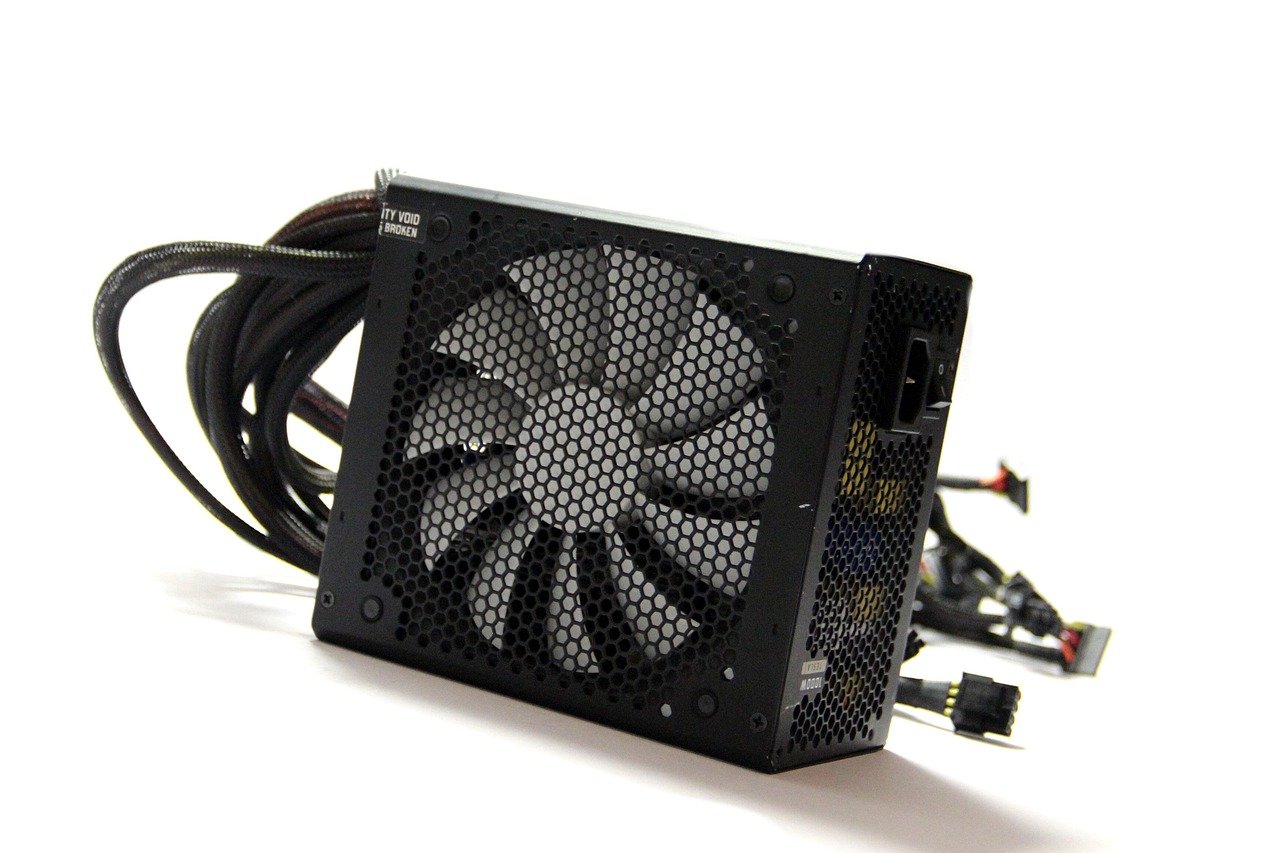
Wattage: How Much Power Do You Need?
The main specification for a PSU is its wattage (W). This tells you the maximum amount of power it can deliver to your system. You need to choose a PSU that provides enough wattage to power all your components, with a little extra headroom to be safe.
Every component, especially the CPU and the GPU, has a rated power draw. Your powerful graphics card is usually the most power-hungry part. To figure out what you need, you can use an online “PSU Calculator.” You enter all your parts, and it will estimate the total wattage your system will use under heavy load.
As a general rule of thumb:
- A basic office PC with integrated graphics might only need a 350W-450W PSU.
- A mid-range gaming PC with a good CPU and a mid-tier graphics card (like an RTX 4060 or RX 7700 XT) will be well-served by a quality 650W-750W PSU.
- A high-end gaming PC with a top-tier CPU and a very powerful graphics card (like an RTX 4080 or RX 7900 XTX) will require an 850W-1000W PSU.
It’s always better to have a little more wattage than you need. The PSU will only draw as much power as the system requests, so having a higher wattage PSU doesn’t mean you’re wasting electricity. It just means it’s running comfortably, not at its absolute limit, which is healthier for the unit.
Efficiency Ratings: Wasting Less Energy
PSUs are not 100% efficient. When they convert power from the wall to power for your PC, some energy is lost as heat. The “80 Plus” rating tells you how efficient a PSU is.
A PSU with an “80 Plus Bronze” rating is guaranteed to be at least 82-85% efficient. A “80 Plus Gold” rated PSU is even better, at 87-90% efficiency. The ratings go up from there (Platinum, Titanium). A more efficient PSU wastes less electricity (saving you a little on your power bill) and generates less heat, which can help keep your whole computer cooler. For most people, a 80 Plus Bronze or 80 Plus Gold rated PSU from a reputable brand offers the best balance of quality and price.
Cables: Modular vs. Non-Modular
PSUs come with a lot of cables to connect to the motherboard, CPU, GPU, and storage drives. You can choose how these cables are attached.
- Non-Modular: All the cables are permanently attached to the PSU. This is the cheapest option, but it means you’ll have a big bundle of unused cables that you have to tuck away somewhere in your case, which can look messy and block airflow.
- Semi-Modular: The essential cables (like the main motherboard and CPU power) are attached, but all the optional cables (for the GPU, storage drives, etc.) are detachable. This is a great middle-ground.
- Fully-Modular: Every single cable is detachable. You only plug in the exact cables you need. This makes building the computer and managing the cables much easier, resulting in a cleaner-looking build with better airflow. This is the preferred choice for most builders, even though it costs a little more.
Chapter 6 Key Takeaways
- The PSU powers every component in your system and is crucial for stability. Never buy a cheap, unknown brand.
- Wattage (W) must be high enough to support all your parts, especially the GPU.
- The 80 Plus rating (Bronze, Gold, etc.) tells you how efficient the PSU is. Gold is a great target for quality.
- Fully-Modular PSUs make building easier and cleaner because you only use the cables you need.
Chapter 7: The House & Lungs – The Case & Cooling
The Analogy: The Office Building and its Air Conditioning
The computer case is the physical house or office building where all your components live. It protects them from dust and damage. But just as important as the building itself is its ventilation system. All the hard work done by the CPU and GPU generates a lot of heat. If that heat builds up, the components will slow down to protect themselves (this is called “thermal throttling”) or even shut off. The cooling system—the fans and heatsinks—are the “lungs” and “air conditioning” of the computer, constantly bringing in cool air and pushing out hot air to keep the team working at peak performance.
The case and cooling system are the final pieces of the puzzle. They house and protect your expensive components while also ensuring they don’t overheat. A good case is easy to build in and provides excellent airflow, while a good cooling system will keep your CPU and GPU running fast and quiet, even under heavy load.
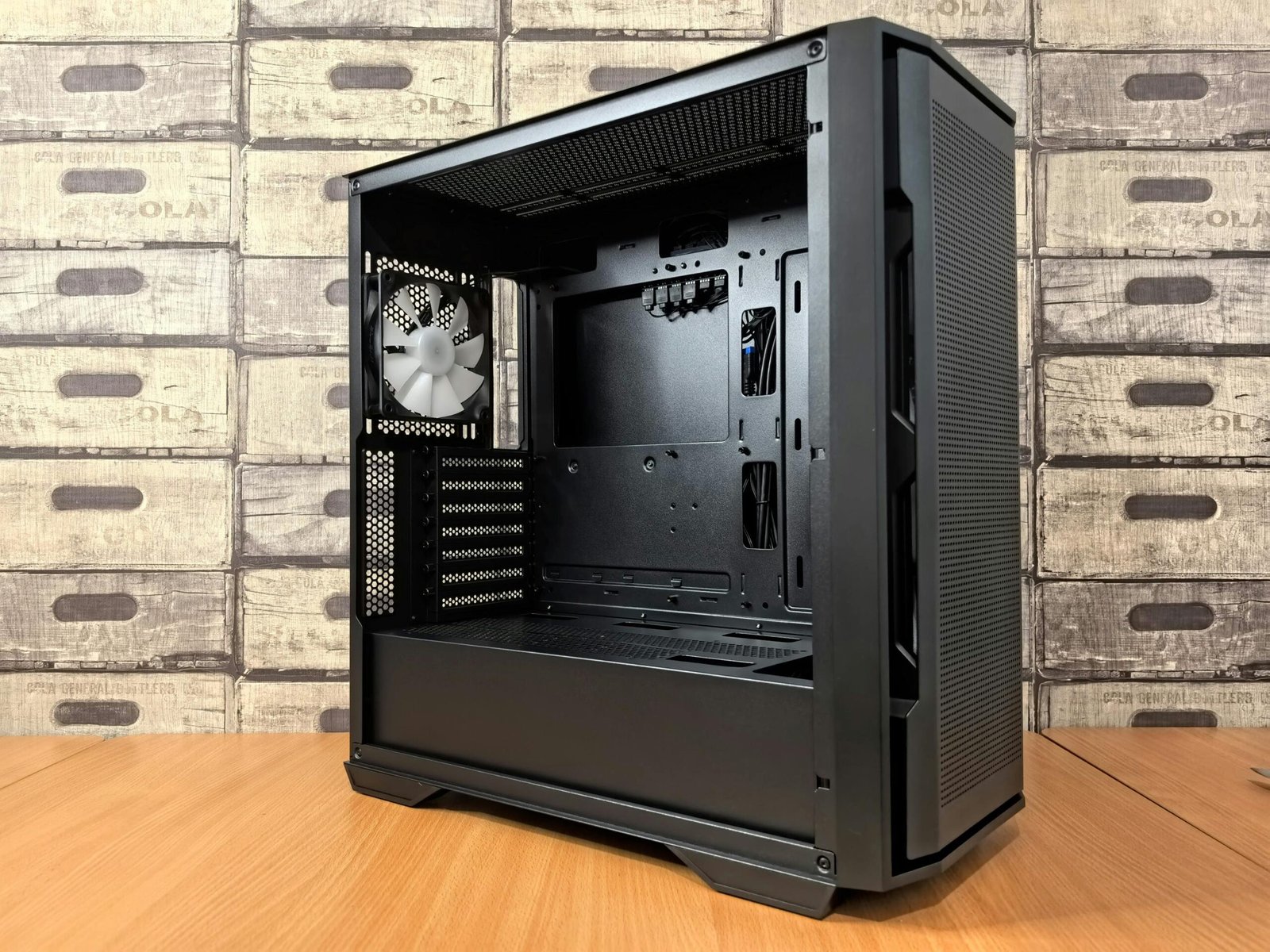
The Computer Case
A case is more than just a box. When choosing one, you need to consider a few things.
- Compatibility: Your case must be large enough to fit your motherboard’s form factor. An ATX motherboard needs an ATX case (often called a “mid-tower”). You also need to make sure it’s long enough to fit your graphics card and tall enough to fit your CPU cooler.
- Airflow: This is the most important job of a case. A good airflow case will have a mesh front panel that allows fans to easily pull in cool air from the outside. Cases with solid glass or plastic front panels might look sleek, but they often suffocate the components and lead to higher temperatures.
- Ease of Building: A well-designed case will have features that make your life easier, like plenty of space behind the motherboard to hide cables, removable dust filters, and tool-less drive bays.
The Cooling System
There are two main ways to cool the hottest component in your system, the CPU.
Air Cooling
This is the most common and straightforward method. An air cooler consists of a block of metal fins (a heatsink) and a fan. The heatsink sits directly on top of the CPU, pulling heat away from it. The fan then blows cool air across the fins to dissipate the heat into the case, where it can be exhausted by the case fans. Air coolers are simple, reliable, and can be very effective. A good quality air cooler is more than enough for the vast majority of CPUs.
Liquid Cooling (AIO)
All-In-One (AIO) liquid coolers are a more advanced option. They work like a car’s radiator. A “block” sits on the CPU and contains a small pump. This pumps a liquid through a tube to a radiator, which is mounted to the case wall. Fans on the radiator then blow the heat out of the case. AIOs can offer superior cooling performance for very high-end, hot-running CPUs and can look very clean and stylish in a build. However, they are more expensive and have more potential points of failure (like the pump) than a simple air cooler.
The Path of Air: A Simple Concept
The goal of case cooling is to create a constant, steady stream of air moving through the case. The standard setup is simple:
- Intake: Fans at the front of the case pull in cool, fresh air from outside.
- Exhaust: Fans at the back and top of the case push the hot air that has collected inside the case out.
This simple front-to-back, bottom-to-top airflow path ensures that your components are always being bathed in cool air and that the hot air they generate is efficiently removed.
Conclusion: Assembling Your A-Team
We’ve now met every key member of the computer hardware team. From the brilliant CEO (the CPU) and its fast workbench (the RAM), to the vast library (Storage) and the master artist (the GPU). We’ve seen how the motherboard acts as the nervous system connecting them all, the PSU provides the power to get work done, and the case and cooling system provide the safe and comfortable environment they need to perform at their best.
The most important lesson in computer hardware is balance. A super-powerful GPU will be wasted if it’s paired with a slow, old CPU. It’s like hiring the world’s best artist but giving them a tiny, slow office with no phone—they can’t do their best work because they are being held back by the rest of the team. A balanced system is one where every component is well-matched to the others, creating a team where no single part is holding the others back.
You are now equipped with the fundamental knowledge to understand what’s inside a computer. You can look at a spec sheet and know what the numbers mean. You can identify the role of each part and understand how it contributes to the whole. The world of computer hardware is constantly changing, with new and faster parts coming out every year, but the fundamental roles of these components—the brain, the workbench, the library—remain the same. Congratulations on completing your first deep dive into the fascinating world of computer hardware!

Thank you for sharing superb informations. Your web-site is so cool. I’m impressed by the details that you have on this blog. It reveals how nicely you understand this subject. Bookmarked this web page, will come back for more articles. You, my friend, ROCK! I found simply the info I already searched all over the place and just couldn’t come across. What a perfect website.
I am glad to know that it provided you all the details whatever you were searching for. thanks for posting this lovely comment or thoughts.
I love the efforts you have put in this, thanks for all the great posts.
thanks for your appreciation.
I was looking at some of your articles on this website and I conceive this internet site is real informative ! Continue putting up.
I?¦ve been exploring for a little bit for any high-quality articles or blog posts in this kind of area . Exploring in Yahoo I finally stumbled upon this site. Reading this information So i am satisfied to express that I have a very excellent uncanny feeling I came upon just what I needed. I so much definitely will make certain to don?¦t forget this website and provides it a look on a continuing basis.
I will right away grab your rss as I can not find your e-mail subscription hyperlink or newsletter service. Do you have any? Kindly allow me recognise in order that I may just subscribe. Thanks.
obviously like your web site but you need to check the spelling on several of your posts. Many of them are rife with spelling issues and I find it very troublesome to tell the truth nevertheless I’ll surely come back again.
Thanks.
Good info. Lucky me I reach on your website by accident, I bookmarked it.
I rattling pleased to find this website on bing, just what I was searching for : D also saved to favorites.